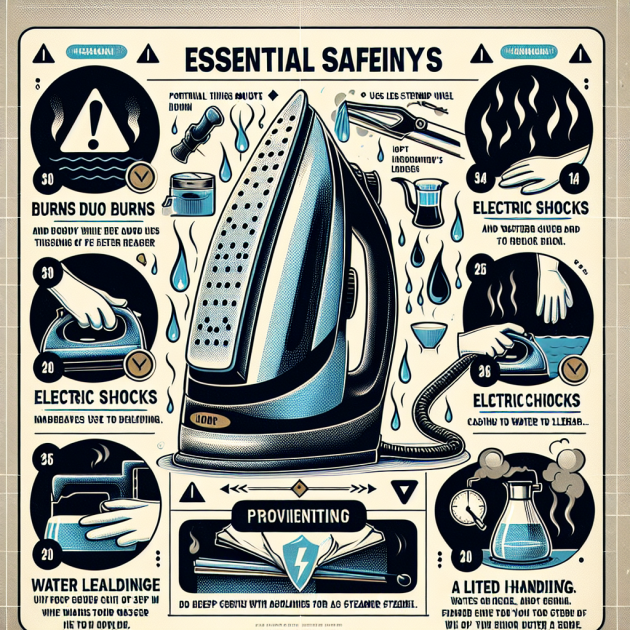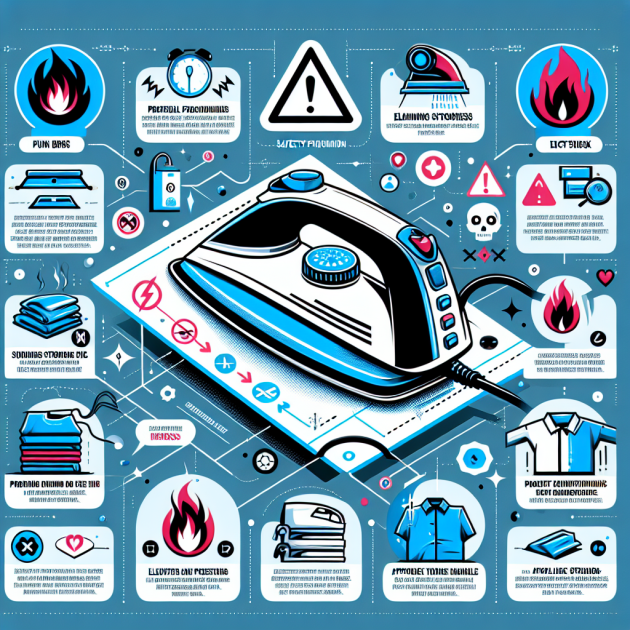What Safety Precautions Should I Take When Using A Garment Steamer?
When utilizing a garment steamer to keep your clothes looking fresh and wrinkle-free, it is essential to prioritize safety. Understanding the necessary precautions can help prevent any accidents or mishaps and ensure that your steaming experience is both efficient and hassle-free. From handling the steamer with care to avoiding direct contact with the steam, this article will provide you with valuable tips and insights on maintaining a safe environment while enjoying the convenience of a garment steamer.
Understanding the Functionality of a Garment Steamer
What is a garment steamer?
A garment steamer is a device that uses hot steam to remove wrinkles and freshen up garments. It is commonly used as an alternative to traditional ironing and is particularly useful for delicate fabrics such as silk or chiffon. Garment steamers work by heating water stored in a tank and allowing the steam to pass through a nozzle onto the fabric, relaxing the fibers and eliminating wrinkles.
Types of garment steamers and their uses
There are two main types of garment steamers: handheld steamers and standing steamers. Handheld steamers are portable and easy to use, making them ideal for travel or quick touch-ups. On the other hand, standing steamers are larger and more powerful, suitable for steaming larger garments or even curtains.
Handheld steamers are best suited for small projects, such as removing wrinkles from a blouse or dress. Standing steamers, on the other hand, are perfect for steaming larger items, such as suits, dresses, or drapes. Both types of steamers serve the same purpose of removing wrinkles, but their size and capabilities make them suitable for different tasks.
Why is safety important while using a garment steamer?
Safety is of utmost importance when using a garment steamer to prevent accidents or injuries. The use of hot steam and electricity poses potential risks, and it is essential to follow safety precautions to ensure a safe steaming experience. By understanding and implementing safety measures, you can enjoy the convenience of a garment steamer without any harm or mishaps.
Safety Precautions during Setup and Usage
Proper placement of the garment steamer
When setting up your garment steamer, it is crucial to place it on a stable, flat surface. Ensure that the surface is heat-resistant and away from any flammable materials. Avoid placing the steamer near curtains, paper, or other items that can easily catch fire. This will minimize the risk of accidents and potential damage to your surroundings.
Handling of the water tank
The water tank is an essential component of a garment steamer, and it requires proper handling. Before filling the tank, make sure the steamer is unplugged and turned off. Use the designated filling cup provided with the steamer to avoid overfilling or spillage. Take caution while handling hot water and ensure that the tank is securely closed before using the steamer.
Plugging and unplugging the steamer
Always remember to plug the garment steamer into a grounded electrical outlet. Avoid using extension cords or adapters as they can overload the circuit and pose a fire hazard. When unplugging the steamer, grasp the plug itself and not the cord to avoid any damage or electric shock. It is vital to handle the power cord with care to prevent any accidents.
Holding the steamer while in use
When using a handheld steamer, it is crucial to hold the device securely and at a safe distance from your body. Avoid pointing the steamer towards yourself or others to prevent accidental burns or steam inhalation. Keep your hands and fingers away from the steam nozzle and never touch the hot plate or any other heated parts of the steamer.

Dealing with Electricity when Using a Garment Steamer
Why you need to be cautious with electrical connections
Electricity is a critical component of a garment steamer, and it is essential to exercise caution while dealing with electrical connections. Ensure that the power cord is in good condition without any fraying or exposed wires. If you notice any damage, refrain from using the steamer and have it repaired by a professional.
Choosing the right outlets
It is crucial to use a grounded electrical outlet when plugging in your garment steamer. Grounded outlets provide an extra layer of protection against electrical shocks and short circuits. Avoid using outlets near water sources, as moisture increases the risk of electric shock. Additionally, never force the plug into the outlet or use any adapters not approved by the manufacturer.
Avoiding water near electrical connections
Water and electricity are a dangerous combination, and it is essential to keep them separate while using a garment steamer. Never pour water directly onto the steamer or immerse the device in water. It is also crucial to avoid steaming near open water sources, such as sinks or bathtubs. By keeping water away from electrical connections, you can minimize the risk of electric shock.
Dealing with power surges
Power surges can occur due to fluctuations in electrical supply and pose a risk to your garment steamer. To protect the device from power surges, consider using a surge protector. Surge protectors can absorb and redirect excess electrical energy, safeguarding your steamer from potential damage or electrical hazards. Investing in a surge protector is a wise precautionary measure for the safe usage of your garment steamer.
Handling Hot Steam and Burn Avoidance
The dangers of hot steam and burn risk
Hot steam can cause burns if not handled properly, and it is essential to be aware of the potential risks. The steam produced by a garment steamer can reach high temperatures and may cause significant burns if it comes into direct contact with your skin. It is crucial to be cautious to avoid accidental burns while using a garment steamer.
Tips to minimize the burn risk
To minimize the risk of burns, it is recommended to wear appropriate clothing while using a garment steamer. Opt for long sleeves and avoid loose-fitting garments that may accidentally come into contact with the steam. Keep a safe distance from the steam and direct it away from yourself or others. It is also advisable to let the steamer cool down before handling or storing it.
Proper positioning while steaming
When using a garment steamer, position yourself in such a way that the steam is directed away from your face, body, and hands. This will minimize the chances of accidental burns or inhaling hot steam. Maintain a consistent and safe distance between the steamer nozzle and the fabric to allow the steam to effectively remove the wrinkles without risking any burns.
Safety precautions for children and pets
Children and pets should be kept away from the area where a garment steamer is being used. The hot steam and potentially scalding water can cause serious injuries if they come into contact with curious children or animals. Create a safe zone while steaming and ensure that children and pets are under adult supervision at all times to prevent any accidents.

Appropriate Dress and Personal Safety Tools
Why appropriate dressing matters
Appropriate dressing is important while using a garment steamer to minimize the risk of accidents or injuries. Avoid wearing loose-fitting or flowing clothes that may come into contact with the hot steam or heating elements. Opt for fitted clothing that provides a protective barrier between you and the steamer.
Recommended safety gloves and glasses
To provide extra protection, consider wearing safety gloves and glasses while operating a garment steamer. Safety gloves will protect your hands from potential burns, while safety glasses will shield your eyes from steam or hot water splashes. These safety tools are particularly useful when using a standing steamer or when steaming large items that require prolonged exposure to steam.
Burn creams and first aid preparation
Accidents can happen, even with the utmost caution. It is advisable to have burn creams and first aid supplies readily available in case of any burns or injuries. Rinse any burns with cool water immediately and apply a burn cream or gel to soothe the affected area. Seek medical attention if the burn is severe or does not heal within a reasonable time.
Preventing inhalation of steam
Inhalation of steam can be harmful, especially if the steam contains any chemicals or contaminants. While using a garment steamer, ensure that the room is well-ventilated to allow the steam to dissipate. Avoid breathing in the steam directly and position the steamer’s nozzle away from your face. If you experience any discomfort or respiratory issues, immediately move to an area with fresh air.
Care and Maintenance of a Garment Steamer
Importance of regular maintenance
Regular maintenance is crucial to ensure the safe and efficient functioning of your garment steamer. By maintaining your steamer properly, you can extend its lifespan and minimize the risk of malfunctions or accidents. Regular maintenance includes cleaning, inspecting, and replacing parts as necessary.
Cleaning after use
After each use, it is important to clean the garment steamer to remove any residue or build-up. Follow the manufacturer’s instructions for cleaning, as different models may have specific cleaning requirements. Empty the water tank, wipe down the exterior, and remove any lint or debris from the nozzle or heating plate. This will prevent blockages and maintain optimal steam flow.
Storage guidelines
Proper storage of your garment steamer is essential to prevent any damage and ensure its longevity. Always ensure that the steamer is completely cooled down before storing it. Store it in a clean, dry area, away from direct sunlight or extreme temperatures. Consider using the original packaging or a protective cover to shield the steamer from dust or accidental damage.
Regular inspection and replacement of parts
Inspect the condition of your garment steamer regularly to identify any worn-out or damaged parts. Check the power cord, plug, and steam nozzle for any signs of wear or malfunction. if you notice any issues, contact the manufacturer or a professional technician for assistance. Follow the manufacturer’s guidelines for replacing parts and never attempt to repair or modify the steamer on your own.

Safe Disposal of Used Water and Cleaning
How to safely dispose used water
The disposal of used water from a garment steamer should be done with caution. Always allow the water to cool down before emptying it. Dispose of the water in a sink, toilet, or appropriate drainage system. Avoid pouring the hot water directly onto any surfaces or down the drain without proper dilution. Ensure that the water is disposed of safely to prevent any harm or damage.
Different cleaning regimen for different garment steamers
Different garment steamers may require specific cleaning regimens, depending on their design and specifications. Follow the manufacturer’s instructions for cleaning to ensure that you are using the appropriate cleaning method. Some steamers may require occasional descaling or deep cleaning to remove mineral deposits or build-up. Adhering to the recommended cleaning routine will keep your steamer in optimal condition.
The role of distilled water in maintenance
Using distilled water in your garment steamer can help prevent mineral deposits or scale build-up. Tap water often contains minerals that can accumulate in the steamer’s tank or nozzle, affecting its performance. Distilled water is free from minerals, ensuring a clean and efficient steaming process. Check the manufacturer’s guidelines to determine whether distilled water is recommended for your specific steamer model.
Preventing scale buildup
To prevent scale buildup in your garment steamer, consider using a descaling solution as recommended by the manufacturer. Descaling removes mineral deposits and helps maintain optimal steam flow and performance. Regular descaling can prolong the life of your steamer and prevent clogs or blockages in the nozzle or tank. Follow the instructions provided in the user manual for effective descaling.
Understanding the User Manual and Safety Instructions
The importance of the user manual
The user manual is a valuable resource that provides comprehensive information about your garment steamer. It contains safety instructions, operating procedures, and maintenance guidelines specific to your steamer model. Reading and understanding the user manual before using the steamer is essential to ensure safe and proper usage.
Specific safety instructions for different models
Each garment steamer model may have specific safety instructions that should be followed to prevent accidents or damage. The user manual will outline these instructions, including any model-specific precautions or warnings. Pay close attention to these instructions, as they are designed to ensure your safety and the optimal performance of the steamer.
Following the manufacturer’s guidelines
To ensure your safety, always follow the manufacturer’s guidelines for setup, usage, and maintenance. These guidelines are provided by the manufacturer to ensure the safe and effective use of the garment steamer. Deviating from these guidelines or using the steamer inappropriately may result in accidents, injuries, or damage to the steamer itself.
Understanding warning labels and signs
Garment steamers often have warning labels and signs to alert users of potential risks or hazards. These warnings should be taken seriously and understood before using the steamer. Warning labels may include information about electrical hazards, hot surfaces, or steam-related risks. Familiarize yourself with these warning labels and adhere to the safety precautions outlined.

Emergency Handling and Unexpected Situations
What to do in case of a malfunction
In the event of a malfunction, it is important to take immediate action to prevent further damage or potential harm. If you notice any unusual behavior or malfunction in your garment steamer, unplug it from the electrical outlet and discontinue use. Contact the manufacturer’s customer service or consult a professional technician for assistance and follow their guidance for repair or replacement.
Handling electrical shocks
If an electrical shock occurs while using a garment steamer, it is essential to take immediate action to ensure your safety. First, disconnect the steamer from the power source by unplugging it. Check the affected area for any visible signs of injury and seek medical attention if necessary. Additionally, have the steamer inspected by a professional before using it again to ensure that it is safe.
What to do in case of a burn
In the case of a burn from a garment steamer, immediately rinse the affected area with cool water for several minutes to help alleviate the pain. Avoid applying ice directly to the burn, as it can further damage the tissue. After rinsing, consider applying a burn cream or gel to soothe the burn and cover it with a sterile dressing or bandage. If the burn is severe or covers a large area, seek medical attention promptly.
When to seek professional help
If you encounter any unexpected situations or face difficulties in handling your garment steamer safely, it is advisable to seek professional help. Whether it is a malfunction, a significant burn, or any other safety concern, consulting a professional technician or seeking medical attention when necessary can provide the appropriate support and guidance to address the issue effectively.
The Role of Proper Training
Importance of training before using a garment steamer
Proper training is essential before using a garment steamer to ensure the safe and effective use of the device. Familiarize yourself with the user manual, safety instructions, and guidelines provided by the manufacturer. Consider undergoing specific training sessions or workshops to obtain hands-on experience and guidance on using a garment steamer correctly.
Using online tutorials and guides
Online tutorials and guides can be a helpful resource when learning how to use a garment steamer. Many manufacturers or experienced users provide step-by-step video tutorials or written guides that demonstrate the proper usage and safety precautions. By utilizing these resources, you can enhance your knowledge and understanding of using a garment steamer safely.
Understanding the steamer functionality prior to use
Before using a garment steamer, take the time to understand its functionality and features. Familiarize yourself with the different settings, controls, and attachments that come with your specific steamer model. This understanding will enable you to make the most of the steamer’s capabilities while using it safely and effectively.
Teaching safety principles to other users
If you are an experienced garment steamer user, consider sharing your knowledge and teaching safety principles to other users. Whether it is a family member, friend, or colleague, educating them about the proper usage and safety precautions will help them avoid accidents or injuries. By promoting safe steaming practices, you are contributing to a safer environment for all users.
In conclusion, understanding the functionality of a garment steamer and practicing safety precautions are essential for a safe and effective steaming experience. By following the guidelines outlined in this article, you can minimize the risks associated with using a garment steamer and enjoy wrinkle-free clothes with confidence. Remember to always prioritize safety, read the user manual, and seek professional help when needed. Happy steaming!





